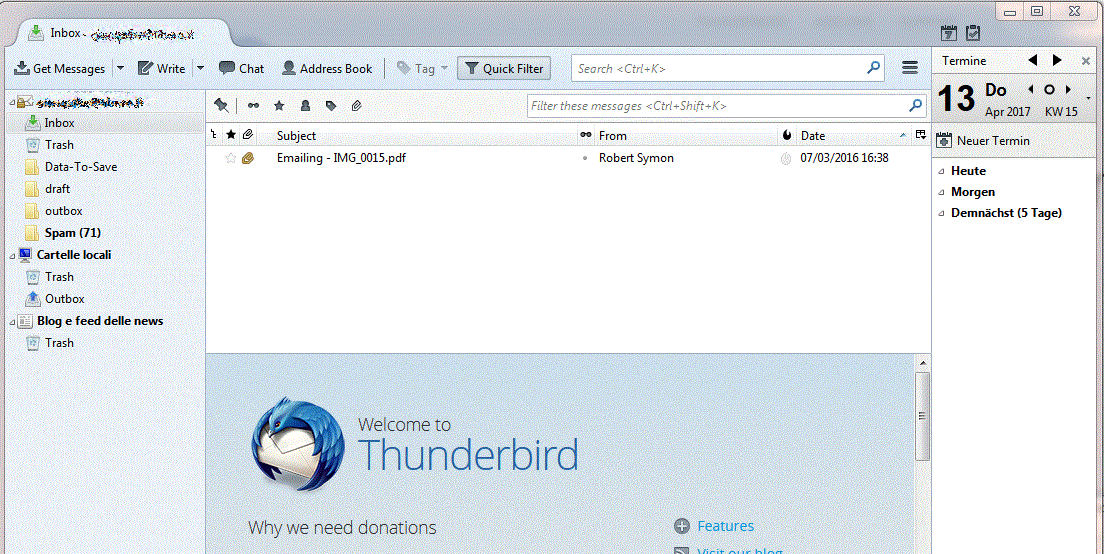
:max_bytes(150000):strip_icc()/010-add-image-to-thunderbird-signature-1173166-d41bc394ecd9444cac1b8ec7e1d1befc.jpg)
For instance US-ASCII space character would be represented with %20.
ADDING SIGNATURE IN MOZILLA THUNDERBIRD 52.2.1 CODE
Special characters are represented using a percentage character followed by two digits representing the octet code of the original character (%HEX-CODE). An URL may contain special character that need special syntax handling in order to be interpreted. An attacker can take advantage of the multiple way of encoding an URL and abuse the interpretation of the URL. This attack targets the encoding of the URL. Buffer Overflow via Parameter Expansion.Other possible outcomes include server crashes and resource consumption if the unexpected queries cause the server to enter an unstable state or perform excessive computation. The attacker may not know the names of fields to request or how other modifications will affect the server response, but by attempting multiple plausible variants, they might eventually trigger a server response that divulges sensitive information. In this particular attack, the fuzzing is applied to the format of the expected templates, creating variants that request additional information, exclude limiting clauses, or alter fields that identify the requester in order to subvert access controls. Fuzzing techniques involve sending random or malformed messages to a target and monitoring the target's response. In the above example, additional information might include social security numbers or salaries. If the server does not verify that the query matches one of the expected templates, an attacker who is allowed to send normal queries could modify their query to try to return additional information.

For example, a client that queries an employee database might have templates such that the user only supplies the target's name and the template dictates the fields to be returned (location, position in the company, phone number, etc.). Many client applications use specific query templates when interacting with a server and often automatically fill in specific fields or attributes. This attack differs from "Restful Privilege Escalation" in that the latter correlates to the inadequate securing of RESTful access methods (such as HTTP DELETE) on the server, while cross-zone scripting attacks the concept of security zones as implemented by a browser.Īn attacker who is authorized to send queries to a target sends variants of expected queries in the hope that these modified queries might return information (directly or indirectly through error logs) beyond what the expected set of queries should provide. This can be accomplished by exploiting bugs in the browser, exploiting incorrect configuration in the zone controls, through a cross-site scripting attack that causes the attackers' content to be treated as coming from a more trusted page, or by leveraging some piece of system functionality that is accessible from both the trusted and less trusted zone. In a cross-zone scripting attack, a page that should be assigned to a less privileged zone is granted the privileges of a more trusted zone. Pages in an untrusted zone would have a lesser level of access to the system and/or be restricted in the types of executable content it was allowed to invoke.

In a zone-based model, pages belong to one of a set of zones corresponding to the level of privilege assigned to that page. This is a privilege elevation attack targeted at zone-based web-browser security. It can be difficult to protect against this attack since the URL can contain other format of encoding such as UTF-8 encoding, Unicode-encoding, etc.Īn attacker is able to cause a victim to load content into their web-browser that bypasses security zone controls and gain access to increased privileges to execute scripting code or other web objects such as unsigned ActiveX controls or applets. An attacker will try to craft an URL with a sequence of special characters which once interpreted by the server will be equivalent to a forbidden URL. Since the server decodes the URL from the requests, it may restrict the access to some URL paths by validating and filtering out the URL requests it received. This is often referred as escaped ending or percent-encoding. A URL may contain special character that need special syntax handling in order to be interpreted. An attacker can take advantage of the multiple ways of encoding a URL and abuse the interpretation of the URL. This attack targets the encoding of the URL combined with the encoding of the slash characters.


 0 kommentar(er)
0 kommentar(er)
